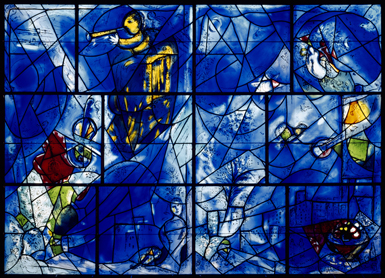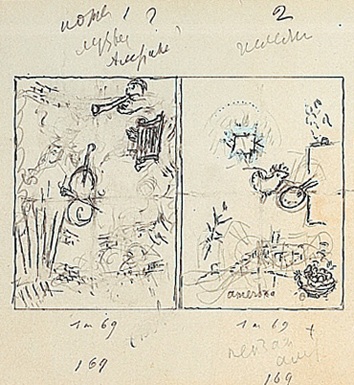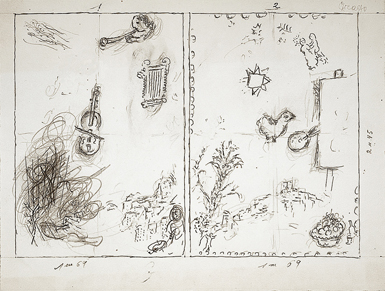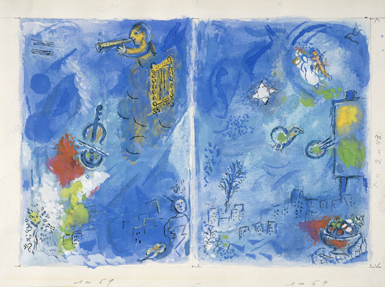


THE AMERICA WINDOWS
Reading from left to right, the first panel of America Windows represents music, with figures of musicians, a musical score, violins, and a horn with a few nonmusical elements. The second panel celebrates the art of painting, showcasing its traditional tools—a palette, brushes, and an easel—as well as examples of various painting genres (florals, landscapes, and still lifes). Comparing Chagall's earlier sketches (1–2) with the completed glass panels (5), it is clear that while the composition did not dramatically change from its early stages to its final form, Chagall abstracted elements and made slight modifications, such as shifting the skyline (in the second panel) toward the left to make it more prevalent.
 |
5


1
2


3
4
(1) Marc Chagall. Chicago, Art Institute, Preparatory Study (detail), 1976. Pencil and ink on paper; 20.5 x 60 cm (8 1/16 x 23 5/8 in.). Musée National d'Art Moderne, AM 1998-81; (2) Chicago, Art Institute, Sketch for Window (1 & 2), 1976. Pencil and ink on paper; 28.5 x 38.7 cm (11 5/8 x 15 1/4 in.). Musée National d'Art Moderne, AM 1998-79; (3) Chicago, Art Institute, Preparatory Maquette (detail), 1976. Pencil, gouache, watercolor, and collage on paper; 20.4 x 59.2 cm (8 1/16 x 23 5/16 in.). Musée National d'Art Moderne, AM 1998-83; (4) Chicago, Art Institute, Final Maquette (1 & 2), 1976. Pencil, gouache, and watercolor on paper; 28.3 x 37.9 cm (11 1/8 x 14 15/16 in.). Musée National d'Art Moderne, AM 1998-85; (5) America Windows (detail), 1977. Stained glass; 244 x 978 cm (96 x 385 in.). The Art Institute of Chicago, a gift of Marc Chagall, the City of Chicago, and the Auxiliary Board of The Art Institute of Chicago, commemorating the American Bicentennial in memory of Mayor Richard J. Daley, 1977.938.